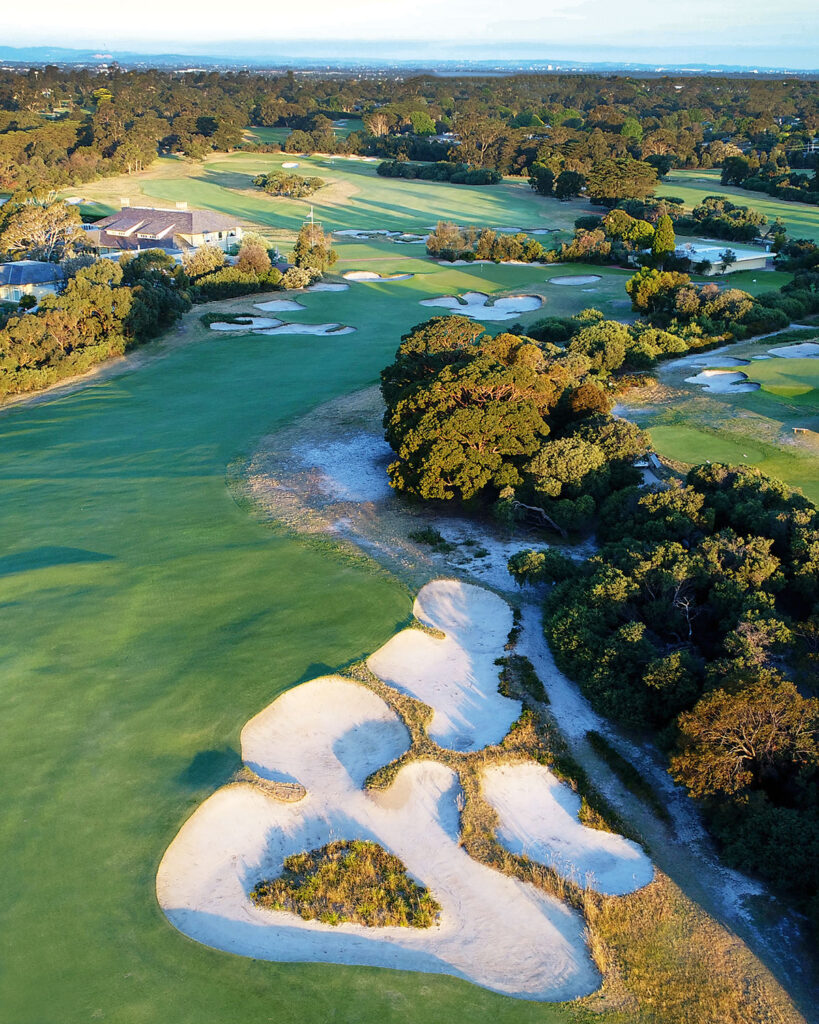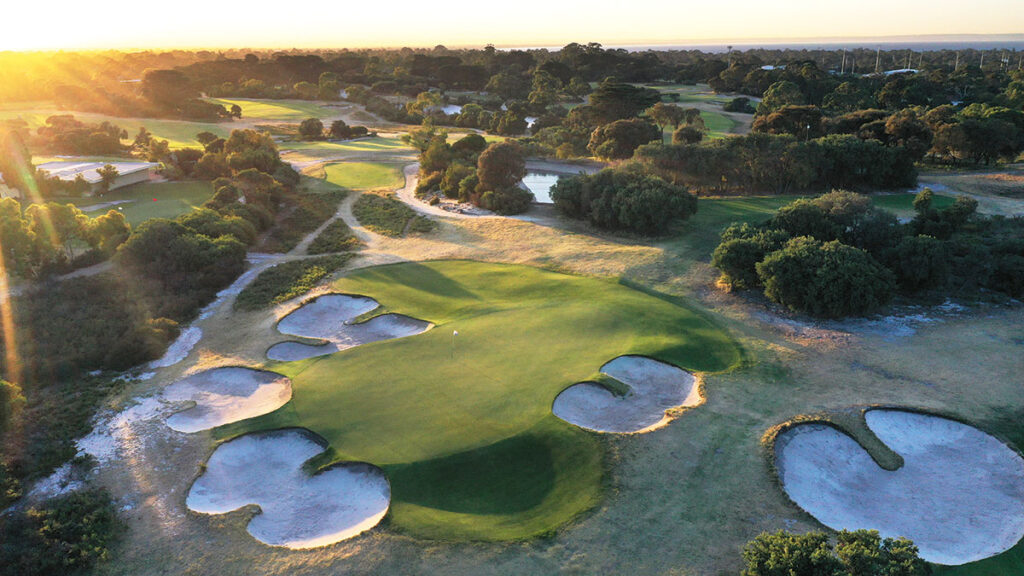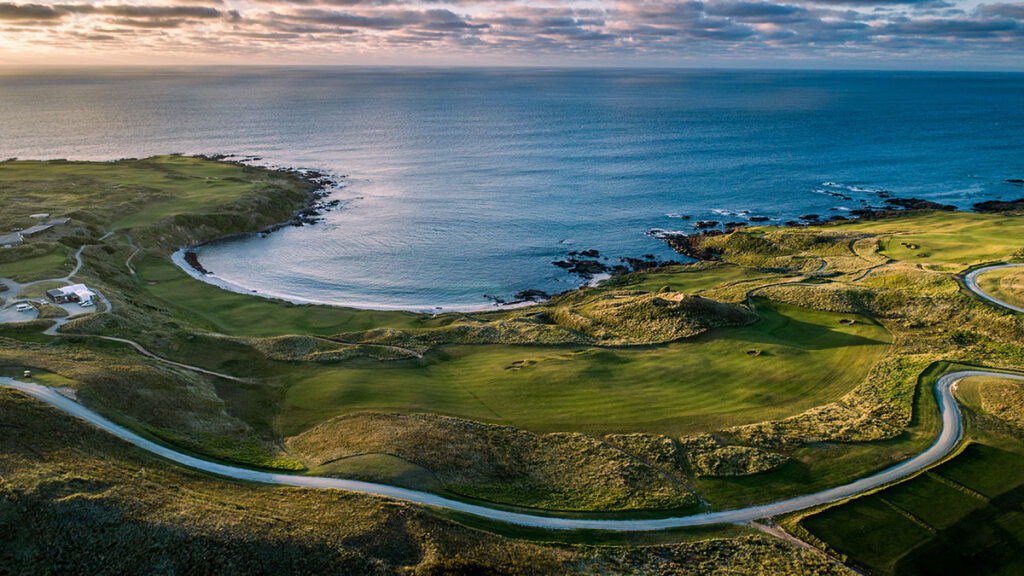Insights gleaned from playing our top two courses in two days.
As short golf trips go, this one tops the lot: playing Royal Melbourne’s West course and Cape Wickham Links on consecutive days. The two top-ranked golf courses in the land, toured on back-to-back afternoons in early April.
Australian golf’s equivalent of swilling a bottle of Grange Hermitage then following it with Hill Of Grace was among the more enviable assignments I’ve undertaken, yet there was meaning to the sojourn. I hadn’t seen either course since 2019 and hadn’t played Royal Melbourne in almost a decade, so I was overdue for a reacquaintance with both. I sit on our panel of judges, but only as a single voice, however I also administer the Top 100 Courses process and collate our panellists’ evaluations. My scores for the two courses did not count towards this latest ranking, although I did feel the need to see both in quick time to understand how and why our panel voted for a switch at the top.

Royal Melbourne was my first stop. I arrived at the great dame of Australian golf on a cloudy but otherwise perfect autumn afternoon for golf. After Melbourne had experienced its driest March on record, 60 millimetres of rain fell in the two days before my visit. In many ways it was a good time to be there – I saw the course as the members do, rather than in a tournament setting where the associated infrastructure, hordes of people and general lack of access pollute the view. The rain had compacted the bunker sand across the West course, which was the only visible clue to the downpour. Famously, surface water doesn’t last very long on the Sandbelt, even after heavy falls.
In all other ways, the course looked in pristine shape. The switch to Wintergreen couch through 2020 and 2021 has improved turf coverage and resilience, and the attractive contrast between the fairways and rough peaks in April. The greens were firm – not tournament firm, but still firm, which was remarkable considering the rain. Pitch marks were difficult although not impossible to elicit from the greens, yet they were shallow. Playing the course was also a tremendous reminder of the shot choices on offer from the fescue aprons wrapping each putting surface. The strategic nature of Royal Melbourne presses your grey matter every time you stand over the ball, but the variety of options ringing the greens remains a hallmark.
Away from the maintained surfaces, the level of care and attention shown towards the vegetation across the property is evident. It is now incumbent upon golf clubs to manage everything within the fencelines, and what is often lost on casual golfers – at Royal Melbourne and elsewhere – is the dedication shown to the parts of a course that aren’t in play. Golf courses are living, breathing, ever-evolving entities and while the management of foliage and vegetation might appear secondary to the playing surfaces, in the grand scheme of things they are equal.
There’s a subtly pulsating rhythm to the flow of a round on the West course. The start is a touch docile on the difficulty front, but that doesn’t last long. As our group walked towards the fifth tee, a jovial staff member driving a drinks cart offered complimentary apples and quipped, “Now the hard holes start.” The way the supposedly easier holes intertwine with the tougher ones is part of the journey of the West course, as a hard-fought par on certain holes can inspire the same sensation as a birdie.
There’s a school of thought that suggests the West loses momentum with the crossing of Cheltenham Road to play holes 13 to 16. While the land there lacks the grand contouring of the “main paddock”, the holes are hardly weak. The little 13th, for instance, dovetails nicely with the 16th, which surely ranks among the best long par 3s in the land.

If Royal Melbourne has a weakness – with an emphasis on if – it’s the obsolete nature of some bunkers for top golfers. I played alongside a fit young man in his early 20s who smashes the ball, but in reality he hits it no further than many accomplished golfers of his age and physique. He took some amazingly aggressive lines off tees that made a joke of some of the West’s longer par 4s. He played sand wedges or half-pitches into multiple 400-plus-metre par 4s and devoured the par 5s on a windless afternoon. However, if that is indeed a criticism, it’s one levelled at the unbridled equipment side of the game rather than the architecture of ‘Royal’. Yet even the longest of hitters need to negotiate the nuances of those genius greens, which is why the course remains a genuine test for the expert golfer and 18-marker in different yet eternally beguiling ways.
Walking onto the West course’s 18th green in the day’s gloaming, I peered first to my right to look up the hill towards the majestic seventh green complex then to my left down the last fairway of the East course and finally towards the setting sun back along the hole I was playing. For four hours I’d been reminded of the magnificence of the West course, however my appreciation for the overall treasure that is Royal Melbourne matched it in that one serene, closing moment.
Catching Cape Wickham on a near-windless afternoon the next day was a first for me. The blanket of grey cloud may have obscured the sunshine, but it also helped keep at bay the whipping winds for which King Island is notorious. There was barely more than a club of breeze for all 18 holes, something I had not encountered there previously.
Such benign conditions allowed me to play the course in a more conventional fashion, with less shot manipulation required. The holes into the prevailing wind were not as fearsome, while still offering ample assistance on the downwind ones. My left-veering tee shot that rode the breeze on the eighth hole was saved by the fairway contours instead of flying into oblivion, and I had a mere half-pitch for my second into the par-4 10th, where the sharply downhill drive ordinarily needs to be struck with as much penetration through the wind as possible. The friendly conditions diluted the difficulty of the challenge without shortchanging the experience.
Ah, yes, the experience. It’s a word you won’t find in the definitions of our judging criteria yet it’s one that golfers frequently refer to when appraising a golf course. The question, What was it like out there? rarely means anything other than how the conditions were or what the experience was like. Break that down a touch further and your assessment naturally evolves from the physical attributes to the overall location and setting. That’s where any Royal Melbourne–Cape Wickham dichotomy becomes tricky – one is ringed by suburbia while the other lies on the edge of a rock in the middle of Bass Strait. Such starkly different settings – just 204 kilometres apart – is part of the magnificence and mystique of any side-by-side evaluation of both courses.

Whether architecturally or as an experience, Cape Wickham feeds the soul. Royal Melbourne does too, just in a different fashion. Playing RM is like walking through the pages of one of golf’s best architecture manuals – you learn something more about the great arena with every interaction. Whereas Wickham is more of a four-hour thrill ride with cresting and troughing levels of frenzied adrenalin. You take in a lot there, too; it’s just that you walk away with your eyes a lot wider and your brain a lot fuller for differing reasons.
Comparing the current condition of the two courses is not a fair fight. Superficially, Royal Melbourne has Cape Wickham well and truly covered, however that’s perhaps not true when you consider the size of the respective fleets of grounds staff and maintenance budgets. There’s something of an arms race waging among the top metropolitan clubs when it comes to the latter, and it’s not a healthy one in a broader context. The fact that our new No.1 course is cared for by a team of just three and on an annual budget of about $350,000 is to be commended. It’s also due in no small part to the grass.
The fescue surfaces had hardly suffered from a dry summer across King Island and all of Tasmania. The fairways and greens were healthy and just lush enough to allow firmness to rule. Cape Wickham highlights the benefits of adopting wall-to-wall fescue in the right climate. It’s a hardy strain and one that just works as a surface to play from.
Some upkeep elements have slipped in recent times. A few bunkers were in need of TLC, but nothing that couldn’t be rectified in quick time. It mattered little. As one person connected to the Cape Wickham project from the start told me, there’s never been a single complaint about the shape of the golf course. Not one.
Then there’s the setting. As I stood on the seventh tee debating which iron to use on the par 3, the unmistakable sound of a distant wave crashing against the rocky shoreline over my shoulder broke my concentration for a welcome moment. You don’t hear that sound in suburban Black Rock. Which raises the argument: should the surroundings count when appraising golf courses? They’re not technically part of the canvas, yet they’re impossible to ignore.
In saying that, part of Cape Wickham’s appeal is the section of the course away from the rugged coastline. Holes like the short seventh, semi-blind eighth and cascading ninth are out of sight of the ocean and lack nothing for it. You can still hear it, though.
I came away from the whistlestop trip enthralled by the twin excursions although unable to pick a clear favourite. It’s like comparing Da Vinci to Rembrandt, Mozart against Beethoven, Porsche with Ferrari. A faithfully cared-for classic and a modern seaside wonder. If offered 10 games across the two courses, where travel and access were not considerations, I would probably split them five apiece. The in-the-ground features are indisputably superior at Royal Melbourne, yet the sensual experience is greater at Cape Wickham.
If there’s one part of this debate that should be unanimous, it’s how blessed we are to have two such outrageously good golf courses as Australia’s best.



